August 8 was International Indigenous Peoples Day — a day to honor the estimated 370 million indigenous people in the world, living across 90 countries, who have struggled throughout history to retain their distinct cultures and ways of life in the dominant societies in which they live.
UC Berkeley researchers, however, have begun to preserve rare audio of indigenous California languages thanks to a new, non-invasive technology — bringing us a step closer to understanding the area’s oldest cultures.
Berkeley researchers are using optical scan technology to transfer recordings from thousands of decaying wax cylinders, preserving audio of 78 indigenous California languages, most of which were recorded more than a century ago. Many of the recordings contain the only audio in the world of several of the languages, and others hold unknown stories and songs.
The collection will be made available to indigenous communities, as well as to scholars and the public.
Learn more on the National Science Foundation’s Science Nation magazine.
Rare audio of indigenous languages saved by invention 100 years later
Optical scan technology is helping researchers at the University of California (UC), Berkeley, preserve audio of 78 indigenous California languages, most of which were recorded more than a century ago. The recordings are on approximately 2,700 wax cylinders that are now barely audible due to issues such as mold. These are the only known sound recordings for several of the languages, and in many other cases, the recordings include unique speech practices and otherwise unknown stories and songs.
With support from the National Science Foundation (NSF), linguist Andrew Garrett, digital librarian Erik Mitchell and anthropologist Ira Jacknis, all of UC Berkeley, are restoring these recordings. The researchers are using a non-invasive optical scanning technique that was developed by Lawrence Berkeley National Laboratory physicists Carl Haber and Earl Cornell. The collaboration with Haber and Cornell is enabling the NSF-funded research team to transfer all 100 hours of audio content from the wax cylinders and improve the recordings, finally making it possible to figure out which language is being spoken and what’s being said.
The rich Native American cultural collection will ultimately be accessible to indigenous communities as well as to the general public and scholars. The linguistic diversity of the world’s estimated 7,000 languages is immense. Modern technologies like this one unlock the documentation to enable new community uses and scientific investigations.
This research was co-funded by the National Endowment for the Humanities; grant number PD-230659-15.
NSF support was provided by award #1500779, “Linguistic and ethnographic sound recordings from early twentieth-century California: Optical scanning, digitization, and access.”


